Overhead sinks for the kitchen: features of selection and installation
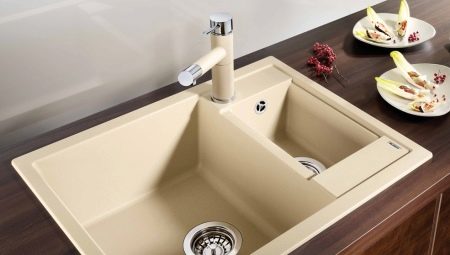
When arranging a kitchen, consumers are bound to be faced with the question of which sink to install so that it is functional, fits appropriately into the interior and suits the cost. One of the options is an overhead sink. We will talk about what to look for when choosing, how to evaluate the advantages and disadvantages, and how to correctly install it, we will talk in our article.
Description
The sinks got their name from the way they were installed. Typically, such a sink is mounted on a simple kitchen cabinet, located in place of the countertop.... Each surface-mounted model has collars on three sides for easy installation. The same side, which is located against the wall, rises in this area, forming an obstacle for water at the docking point.
Most often, overhead sinks are rectangular in shape. Their edges are rounded. Since the corners are smoothed in this case, it is quite easy to clean and care for the sink. There may be not only the main, but also an additional bowl.
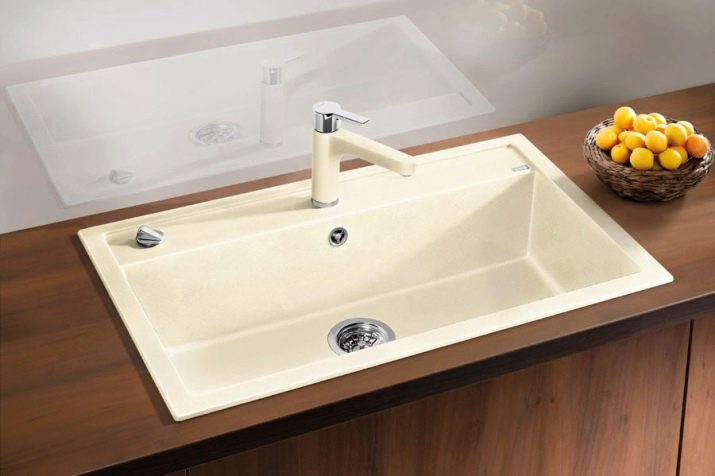
Also, in some models, a wing is provided, which serves as a stand in order to place washed dishes or food there. It can be located either one at a time or on both sides of the bowl.
An emergency drain is most often located at the back of the sink. It is provided in case the water level in the bowl is critical. When installed, it connects to the main drain. The vast majority of models have a grid that filters out food and debris... It is very functional, since it is not only able to protect the drain from blockages, but also to block it if necessary.
The curbstone under the sink is a box that does not have a back side and shelves inside.Most often, housewives place a trash bin or some kind of kitchen utensils there. The box is closed with doors made of material that the consumer considers appropriate.
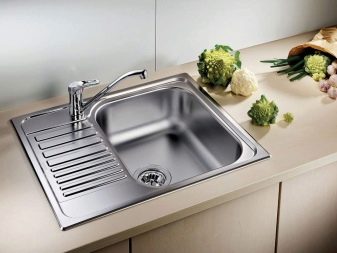
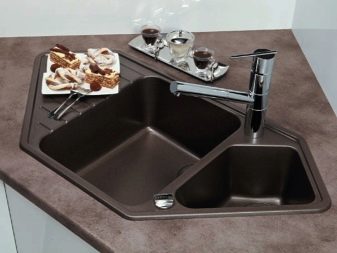
Features and dimensions
The overhead sink is available in a square or rectangular shape. Its corners are slightly rounded. The side against the wall is always raised to prevent water from getting behind the cabinet. With the help of the rest of the sides, the model is attached to the table top.
Considering the ideal sink dimensions, it must be wide enough so that the extended elbows are within the bowl. Compact shells have a depth of about 10-12 cm, standard ones - from 13 to 20 cm, and large ones - from 20 to 30 cm. As for the width, the smallest models start from 50 cm, slightly more - from 60 cm. The length can vary from 40 up to 150 cm.
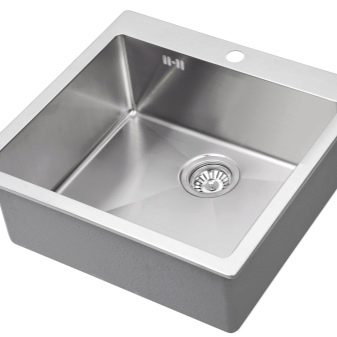

There are several standard lengths and widths. Models 40x40, 50x50, 50x60, 60x60 cm are in the greatest demand. Models with dimensions of 800x600 and 800x500 mm are also popular. Most often, consumers choose a sink size of 60x60 cm.
The sink depth can be from 16 to 19 cm. It is carried out in several variations. A sink can be purchased with only one large bowl. There may be two containers, but in this case their volume will be less. There are also models with a wing, as well as corner products.
Among the features, we can additionally note the fact that an overhead sink is quite easy to install on your own, without contacting specialists.
Special tools for this process are practically not required, it is enough just to place the container on the countertop.
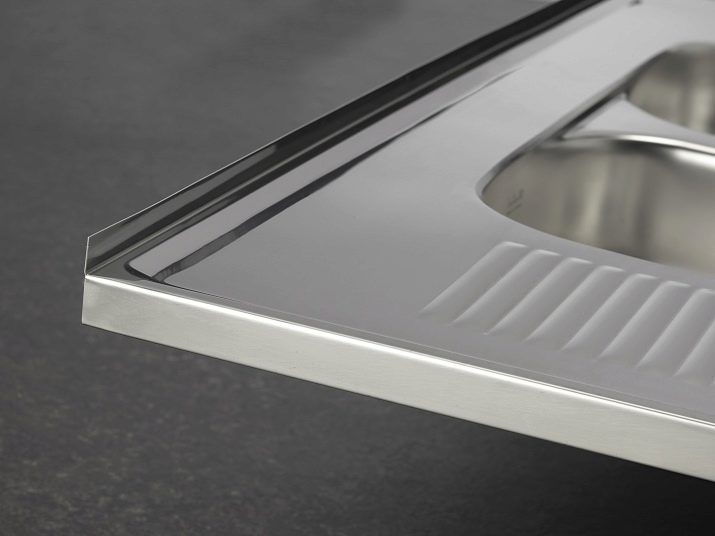
Advantages
These models have a huge number of advantages. The main ones are: affordable price, ease of installation and functionality. Many people make a choice in favor of a certain kitchen sink, focusing on the price. It should be noted that the inset sink has a higher cost, which allows significant savings on this option.
Simplicity of installation cannot be ignored. It doesn't take too long, and it can be done on its own. If the work is done carefully and correctly, the result will delight the consumer for a long time.
Models are presented in a variety of sizes and shapes. You can choose the right sink for each specific case, focusing on the dimensions of the kitchen and the size of the countertop. The same applies to the design: the consumer will be able to choose the sink in the desired color, for example, not only metal, but also white or gold.
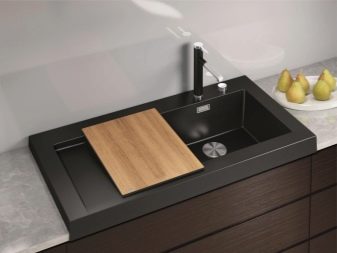
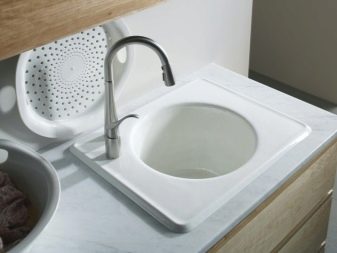
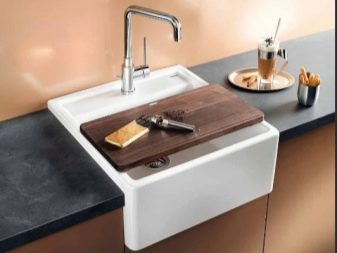
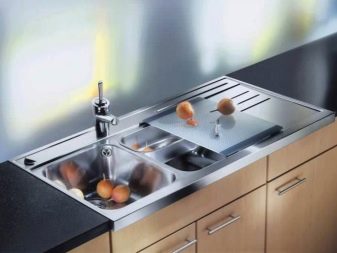
disadvantages
However, with all the advantages available, it would be wrong not to pay attention to the disadvantages. For example, such a sink is most often not shock-resistant and can deform as a result of external influences. With strong blows, dents will remain on it. In some cases, the sink becomes unusable. Careless handling can lead to scratches.
If the sink plate does not fit snugly against the wall, it can cause some problems. For example, water can accumulate behind the curbstone, which over time will lead to its deterioration. In order to avoid such consequences, it is advisable to use a sealant.
However, consumers note that There are not so many disadvantages of overhead sinks, moreover, all of them can be stopped.
It should also be noted that due to the low cost of the models, the buyer still will not be the loser.

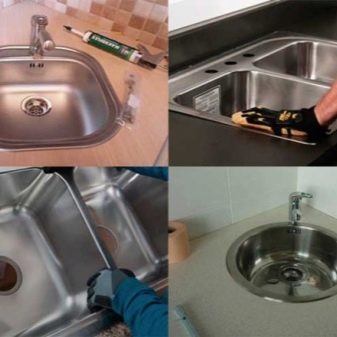
Material selection
Most often, overhead structures are made of thin sheet steel. They can be either glossy or matte. Decor is often used. Glossy sinks are more difficult to care for, but they look catchy and effective. On decorated surfaces, defects and dirt are not so conspicuous.
Manufacturers offer models made from a variety of materials. Look very bright ceramics, fragranite, etc. However, if was selected stainless steel, it is worth making sure that its thickness is as large as possible. These sinks will be more reliable and will last longer. In addition, steel models are affordable.
Also, consumers often choose models made made of artificial stone. Compared to stainless steel, they are better at absorbing noise. Sinks made made of composite materials, have a wider assortment. They are made in different colors and can be matched to any kitchen design. However, they are quite heavy.

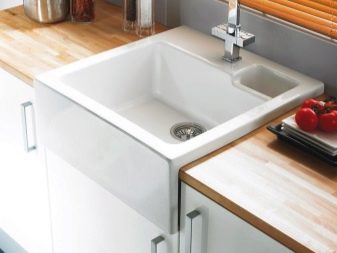
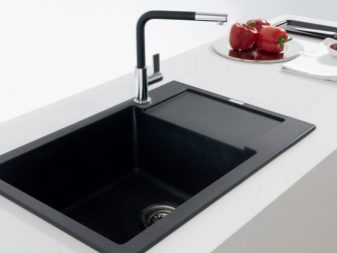
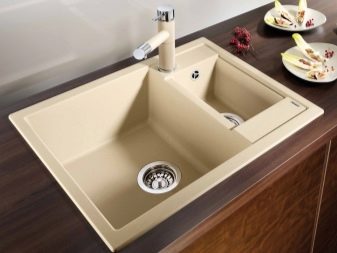
Installation
Overhead sinks can be installed either on the countertop or partially into it. You need to choose an option based on the dimensions of the room... If there is not enough free space, it is best to choose a model with a small bowl. In the case of a large kitchen, you can put a deep and voluminous sink. Models that are close to a meter will look good only in conditions of sufficient space.
As for the installation itself, it can be divided into 4 stages... The first of them involves cutting holes in the table top through which the drain will be made. This is true for models that do not have a side or rear connection. After that, a drain pipe and, if possible, a mixer are installed on the sink. Next, the sink is installed on the countertop itself and a siphon is connected to it. After that, if necessary, electricity is supplied to provide the backlight.
In the case when the sink is installed partially in the countertop, the prepared hole must clearly match the bowl itself in size and shape. Therefore, the easiest way is to install a sink, which is located on the table. In this situation the only hole that will be required will be quite small and designed for the drain pipe.
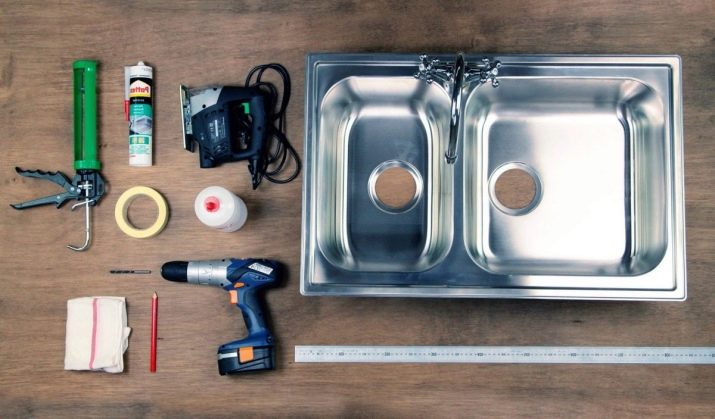
If the sink is purchased from a reputable manufacturer, a stencil often comes with it, by which you can cut a hole in the tabletop yourself. This minimizes the risk of potential errors. However, before starting cutting, in any case, you need to calculate and double-check everything several times, since then it will be impossible to fix anything.
The sink is quite easy to connect to the sewerage and water supply. In fact, it is an ordinary sink. It must be connected using flexible hoses, which must be carefully placed under the countertop so that in the case of an open structure, everything looks beautiful. Be sure to use silicone sealants, which will reliably seal the pipe joints. Next, you need to install the bowl itself. Before that the sealant is gently applied to the edges of the hole. So the connection will be airtight, and water that gets past the sink will not be poured under the sink.
At the end of the work, the power supply is connected, if provided. LED backlighting is not yet very popular among users in our country, but if it is available, you must follow the instructions prepared by the manufacturer. The sink itself will need to be checked to exclude the possibility of leaks.
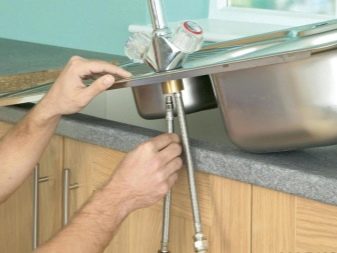
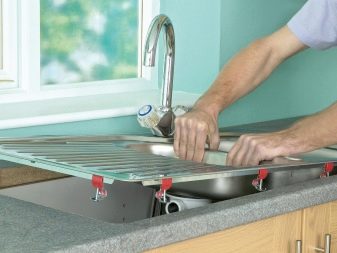
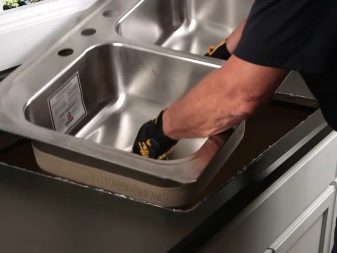
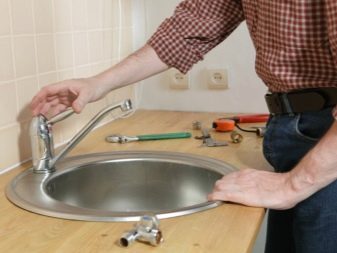
For information on the features of overhead sinks, see the next video.








